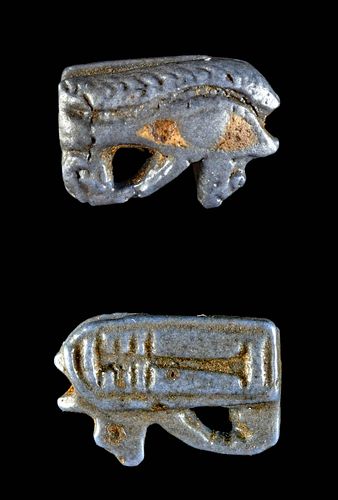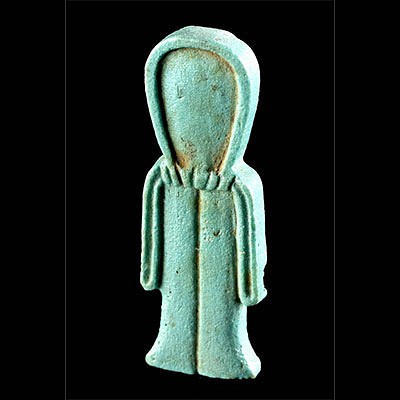Egyptian Faience Amulet Wadjet Eye w/ Djed Pillar
Lot 1a
About Seller
Artemis Fine Arts
686 S Taylor Ave, Ste 106
Louisville, CO 80027
United States
Selling antiquities, ancient and ethnographic art online since 1993, Artemis Gallery specializes in Classical Antiquities (Egyptian, Greek, Roman, Near Eastern), Asian, Pre-Columbian, African / Tribal / Oceanographic art. Our extensive inventory includes pottery, stone, metal, wood, glass and textil...Read more
Categories
Estimate:
$500 - $750
Absentee vs Live bid
Two ways to bid:
- Leave a max absentee bid and the platform will bid on your behalf up to your maximum bid during the live auction.
- Bid live during the auction and your bids will be submitted real-time to the auctioneer.
Bid Increments
| Price | Bid Increment |
|---|---|
| $0 | $25 |
| $300 | $50 |
| $1,000 | $100 |
| $2,000 | $250 |
| $5,000 | $500 |
| $10,000 | $1,000 |
| $20,000 | $2,500 |
| $50,000 | $5,000 |
| $100,000 | $10,000 |
| $200,000 | $20,000 |
About Auction
By Artemis Fine Arts
Nov 4, 2021
Set Reminder
2021-11-04 10:00:00
2021-11-04 10:00:00
America/New_York
Bidsquare
Bidsquare : Ancient & Ethnographic Art Through The Ages
https://www.bidsquare.com/auctions/artemis-gallery/ancient-ethnographic-art-through-the-ages-7799
Ancient art from Egypt, Greece, Italy and the Near East, as well as Asian, Fossils, Pre-Columbian, Native American, African / Tribal / Oceanic, Fine art, and much more! All categories, all price ranges... all legally acquired and guaranteed to be as described or your money back. Artemis Fine Arts info@artemisfinearts.com
Ancient art from Egypt, Greece, Italy and the Near East, as well as Asian, Fossils, Pre-Columbian, Native American, African / Tribal / Oceanic, Fine art, and much more! All categories, all price ranges... all legally acquired and guaranteed to be as described or your money back. Artemis Fine Arts info@artemisfinearts.com
- Lot Description
Egypt, Late Dynastic to Ptolemaic Period, ca. 664 to 30 BCE. A fascinating, mold-formed faience amulet enveloped in a navy-hued glaze and depicting a wadjet, also known as a wedjat or "Eye of Horus" - an ancient ocular symbol of protection - on one side and a hieroglyph of a djed pillar - a glyph denoting concepts of stability, endurance, and rejuvenation - with a serpent on the other. The eye components are finely incised on one of the sides and adorned with white inlays for the sclera, while the structure of a minimalist djed pillar is carved on the other. A suspension hole is perforated laterally through the amulet for suspension. Size: 0.5" L x 0.3" W (1.3 cm x 0.8 cm)
Symbolic of health, healing, and protection, the wadjet is one of the oldest symbols in Egyptian writing. In ancient Egyptian mythos, the falcon god Horus controlled the skies, the sun, and the moon. The sun (represented as the right eye of Horus) rose each day and gave life-giving energy to the crops and gods alike; when the sun set, the moon (represented as the left eye of Horus) rose over the land and provided a guiding path to the afterlife for the recently deceased.
Also one of the most ancient symbols in Egyptian culture, the djed pillar has a myriad of incredibly diverse interpretations. According to contributing writer Terence DuQuesne, "The djed pillar is one of the most important symbols of Osiris, lord of the netherworld, protector of the justified soul, and judge of the dead. Osiris is also a deity of plant fertility, and the pillar may be a schematic representation of a sacred tree, though the fact that early examples are made of ivory militates against this theory. Alternatively, it could represent a pole to which sheaves of grain were attached." (Hornung, Erik and Betsy M. Bryan, eds. "The Quest for Immortality: Treasures of Ancient Egypt." National Gallery of Art, Washington, 2002, p. 111)
Provenance: private Toronto, Ontario, Canada collection, by descent, acquired in Egypt in 1894 to 1896
All items legal to buy/sell under U.S. Statute covering cultural patrimony Code 2600, CHAPTER 14, and are guaranteed to be as described or your money back.
A Certificate of Authenticity will accompany all winning bids.
PLEASE NOTE: Due to recent increases of shipments being seized by Australian & German customs (even for items with pre-UNESCO provenance), we will no longer ship most antiquities and ancient Chinese art to Australia & Germany. For categories of items that are acceptable to ship to Australia or Germany, please contact us directly or work with your local customs brokerage firm.
Display stands not described as included/custom in the item description are for photography purposes only and will not be included with the item upon shipping.
#167147Wearable as a bead or pendant. Loss to pigment of white inlays. Expected abrasions, commensurate with age. Otherwise, intact and excellent.Condition
- Shipping Info
-
All shipping is handled in-house for your convenience. Your invoice from Artemis Gallery will include shipping calculation instructions. If in doubt, please inquire BEFORE bidding for estimated shipping costs for individual items.
-
- Buyer's Premium



 EUR
EUR CAD
CAD AUD
AUD GBP
GBP MXN
MXN HKD
HKD CNY
CNY MYR
MYR SEK
SEK SGD
SGD CHF
CHF THB
THB













